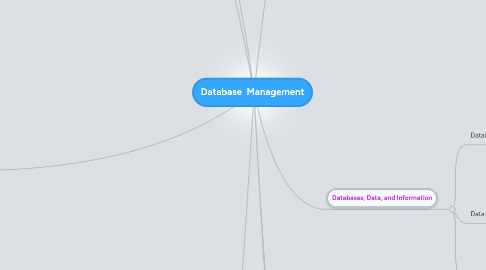Database Management
Door Napaporn Vaiborisut


1. The Hierarchy of Data
1.1. • Data is organized in layers – Files, records, fields, character
1.2. • A character is one byte – Numbers, letters, space, punctuation marks, or other symbol
1.3. • A field is a combination of one or more related characters – Field name – Field size – Data type
1.4. • Common data types includ
1.5. • A record is a group of related fields – A primary key uniquely identifies each recor
1.6. • A data file is a collection of related records
2. Database Management Systems
2.1. • A data dictionary contains data about each file in the database and each field in those file
2.2. • A DBMS provides several tools that allow users and programs to retrieve and maintain data in the databas
2.3. • A query language consists of simple, English‐like statements that allow users to specify the data to display, print, or stor
2.4. • Query by example (QBE) provides a GUI to assist users with retrieving dat
2.5. • A form is a window on the screen that provides areas for entering or modifying data in a database
2.6. • A report generator allows users to design a report on the screen, retrieve data into the report design, and then display or print the repor
2.7. • A DMBS provides a variety of techniques to restore the database to a usable form in case it is damaged or destroye
3. Relational, Object‐Oriented, and Multidimensional Databases
3.1. • A data model consists of rules and standards that define how the database organizes dat
3.2. • A relational database stores data in tables that consist of rows and columns – Each row has a primary key – Each column has a unique nam
3.3. • A relationship is a link within the data
3.4. • Structured Query Language (SQL) is a query language that allows users to manage, update, and retrieve dat
3.5. • An object‐oriented database (OODB) stores data in object
3.6. • Examples of applications appropriate for an object‐oriented database includ
3.7. • A multidimensional database can store data in more than two dimensions of data – Sometimes known as a hypercube – Can consolidate data much faster than a relational databas
3.8. • A data warehouse is a huge database that stores and manages the data required to analyze historical and current transaction
4. Database Administration
4.1. • It is important to have a carefully designed databas
4.2. • Employees should learn how to use the data in the database effectively – Interact with database – Identify new data for the database – Maintain the databas
5. Objectives Overview
5.1. Define the term, database, and explain how a database interacts with data and information.
5.2. Define the term, data integrity, and describe the qualities of valuable information.
5.3. Discuss the terms character, field, record, and file.
5.4. Describe file maintenance techniques and validation technique.
5.5. Differentiate between a file processing approach and the database approach.
5.6. Discuss the functions common to most database management systems.
5.7. Describe characteristics of relational, object‐ oriented, and multidimensional database.
5.8. Explain how to access Web database.
5.9. Identify database design guidelines and discuss the responsibilities of database analysts and administrator.
6. Databases, Data, and Information
6.1. Database
6.1.1. • Collection of data organized in a manner that allows access, retrieval, and use of that data.
6.2. Data
6.2.1. • Collection of unprocessed items • Text • Numbers • Images • Audio • Vide
6.3. Information
6.3.1. • Processed data • Documents • Audio • Images Vide
7. Maintaining Data
7.1. File maintenance refers to the procedures that keep data current
7.2. Users add new records to a file when they obtain new dat
7.3. Users modify a record to correct inaccurate data or update old dat
7.4. When a record no longer is needed, a user deletes it from a file
7.5. Validation compares data with a set of rules or values to find out if the data is correct
8. File Processing Versus Databases
8.1. File processing syste
8.1.1. • Each department has its own set of files • Used for many years • Have data redundancy • Isolate dat
8.2. Database approach
8.2.1. • Programs and users share data • Reduce data redundancy • Improve data integrity • Share data • Allows easier access • Reduces development time • Can be more vulnerabl
